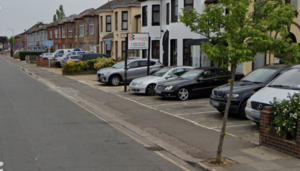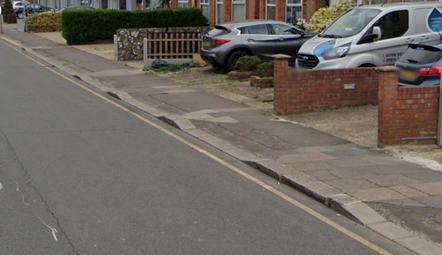Curious about pavement crossovers? Read on!
The humble pavement has many uses – obviously, to enable pedestrians to travel out of the way of traffic, but also as a place to chat and play games, and even as an artist’s canvas. But pavements – technically called ‘footways’ – can also be a bit of an obstacle course, plagued with improperly parked cars, rubbish bags and wonky paving slabs.
And then there are those awkward dips that allow car owners to drive their vehicles across the pavement to the safe haven of their front garden parking space or driveway. These dips are known as pavement crossovers (or dropped kerbs) and have become the focus of increased concern for a number of environmental and social reasons.


Since 1995 there has been an explosion in the number of crossovers because of changes to ‘permitted development’ rules which made it easier for householders to convert their front gardens into parking spaces. Research by Direct Line Home Insurance, carried out in 2021, found that 6.6 million people across the United Kingdom have turned some or all of their front garden into parking. Notably, London came top, accounting for nearly 1.2 million households (18% of all conversions in the UK).
You don’t have to be Brain of Britain to work out that millions of front gardens converted into parking spaces give rise to millions of crossovers. It also means millions of spaces in roads in front of houses have to be kept clear and cannot be used for anything else. Lambeth Council recently said that more roadside space in the borough is now used for private driveways than is given over to bus lanes.
Ironically, home charging Electric Vehicles is making the situation worse, and we could see a further wave of front garden conversions and crossovers as more people switch to Electric Vehicles. Although Direct Line’s research did not mention whether Electric Vehicle ownership is encouraging front garden conversions, it is interesting to note its findings that 3.5 million householders in the UK were planning to convert some or all of their front garden into a driveway, while a further 4.8 million were considering doing so in the future.
So, how do crossovers and associated front garden parking undermine the urban environment? Here are some of the problems:
- Privatisation of public space, free to the householder. Crossovers and front garden parking conversions require part of the road to be kept clear permanently. Nothing else can be done with that space even if it is needed for green infrastructure, such as rain gardens or trees, cycle storage, Electric Vehicle charging points or even car parking, safe crossing points, etc.
- Costly pavement damage. While councils charge householders to install pavement crossovers, they can’t charge for repairing a pavement damaged by a car driving over it. Note, though, that where a crossover has been damaged by a heavy goods vehicle or a skip, the householder will be required to pay for any repairs – see, for example, Redbridge Council’s policy and Luton’s policy.
- Danger for pedestrians. Pavements should be a safe, pleasant and navigable for all. Crossovers can – and should – be engineered to ensure the surface is even but in fact create an uneven pavement which is harder to negotiate for pedestrians and wheelchair or mobility aid users. There’s also the problem of bigger cars overhanging the footway and causing an obstruction. Note that the rules about whether cars parked in front gardens can overhang the pavement are unclear. We’re looking into this and will update this blog in due course. However, we believe that if a council’s crossover policy states cars should not overhang the pavement, then they can enforce this rule, so we suggest all councils should make this clear in their policy.
- Carbon footprint. At a time when society needs to urgently reduce its carbon emissions by shifting to active, shared and sustainable travel, crossovers instead enable drivers to avoid parking controls and costs, so removing a key lever for discouraging car trips.
- Controlled parking zones (CPZs). Introducing CPZs, the purposes of which are to prioritise parking for local people and increase road safety, becomes complex because crossovers can’t be blocked.
- Degraded streetscapes. Crossovers are an eyesore because householders in most neighbourhoods are free to remove walls, fences, hedges or gates in the front of their property without planning permission. Furthermore, paved-over front gardens can’t absorb rainwater (though this is resolved with a genuinely permeable surface), with the result of increased surface water flooding and sewer spills into rivers caused by overloaded drains; they also cause loss of vital habitat and reduce natural air-cooling and community cohesion.
- Unfairness. Tax and water rate payers foot the bill for the problems caused by crossovers and front garden parking, even though many don’t own a car. In outer London roughly a third of households don’t own a car. In inner London it’s nearer two thirds.
Public space – rebalancing priorities
This state of affairs raises the issue of whether crossovers are a fair and appropriate use of public space. To give an idea of how much public space is taken up by crossovers, Lambeth Council assessed all of its kerbside in 2022 and found that only 6% had ‘sustainable uses’, such as street trees, cycle lanes, Electric Vehicle bays, bus lanes and bus stops, and pedestrian crossings (see Lambeth Council’s Kerbside Strategy document, page 9). As for the remaining kerbside, parking accounted for 46%, double yellow lines 24%, single yellow lines 15%, while 9% was taken up by ‘driveways’ (i.e. space where there is a crossover).
The Council identified 579,000 linear metres (or 579km) of kerbside in Lambeth – the same distance from Lambeth to Edinburgh, and an area equivalent to 291 acres or 3.5 Brockwell parks (see pages 5 and 6 of the Strategy document). The Council further found that 9% of driveways equates to 52,110 metres or just over 52.km. That’s a lot of kerbsides devoted to crossovers, and this is just for one London borough.
Lambeth Council concluded that the allocation of kerbside space did not align with its ambition for Net Zero by 2030, and nor was it a fair use of space when most people do not own a car. As a result, Lambeth’s Climate Action Plan commits to allocating 25% of total kerbside space to sustainable uses by 2030 (an increase of 19%), including making more provision for bus lanes and Electric Vehicle charging points. In making these kinds of changes, Lambeth is bringing more kerbside into use by all of the community, not just people who drive.
How boroughs control crossovers
In order to park legally in a front garden, a householder must obtain the relevant local council’s permission for a pavement crossover. Installation of the crossover is then undertaken by the council but paid for by the householder. Councils carry out the work in order to ensure that the footway is properly strengthened to take the weight of cars, thereby protecting the services located underground, and because they can guarantee that various specifications, such as the width of the crossover, have been met.
Householders who use a crossover that has not been approved and constructed by the relevant local council are breaking the law and will be liable for enforcement or prosecution. Accordingly, those planning to install front garden parking and a crossover need to familiarise themselves with a number of local authority rules.
Planning permission for a crossover may also be necessary for a new or extended crossover, and a householder should always check the planning rules of the local authority, even when a vehicle crossover policy mentions what appears to be an exhaustive list of scenarios that require permission.
Regardless of whether planning permission is called for, householders must comply with the terms of the applicable vehicle crossover policy when applying for a new crossover or an extension to an existing one. Policies vary slightly from council to council, but typically cover a range of matters, including setting out the minimum size of a front garden; the minimum safe distance from a junction; the maximum width for a crossover; and the maximum height of fences, walls and shrubs at the front of the property. Some policies also contain front garden parking designs and planting suggestions.
When considering a crossover application, a council will also have regard to the placement of any existing street furniture, local demand for on-street parking, the proximity of bus stops, and so on. It follows that not every application is approved, although the above-mentioned research by Direct Line Home Insurance found that the approval rate in London was 90%.
The car continues to dominate, at least for now
It is striking how accommodating many local authorities are when it comes to entertaining applications for crossovers, including being open to moving street furniture such as lamp posts and utility boxes. Householders can even apply to have trees removed in certain circumstances. Even though an applicant must pay for the associated costs of installing a crossover, the policies reveal councils often subsidise the crossover (by not charging enough) and enable conversions of gardens which are simply not big enough for modern cars, so they end up overhanging the pavement or blocking the pathway to the front door (with the result that emergency services would struggle to get in). Notably, in early 2024, in response to pressure from residents for home charging, Richmond upon Thames reduced its minimum garden size for crossover applications by nearly half, although the Council makes it clear that cars must not overhang the pavement. That said, initiatives such as Lambeth’s Kerbside Strategy signal a shift, and it is interesting to note that Hackney and Hounslow councils are also rethinking kerbside management, with a view to creating healthier, greener and safer neighbourhoods. Related to all of this is the fact that a number of crossover policies have been reviewed in recent years to ensure they are fit for purpose with regard to climate change and the relevant council’s climate change targets. Waltham Forest carried out such a review in May 2022 and now restricts conversions to gardens which are big enough to accommodate cars and they charge the full cost of installing the crossover.
When it comes to allocating kerbside to different uses and road users, progress in London is pretty slow, but for the most part it’s going in the right direction.
Can a pavement crossover be taken away?
Yes, councils can take away a crossover. As part of the application process for a crossover, householders are required to enter into a legal agreement (a deed of covenant) with the relevant council, which is then registered on the property’s title deeds. Breach of the agreement may result in enforcement action and removal of the crossover. So, for example, a council can remove the right to use a crossover and convert it back to its original state if a vehicle is seen overhanging the footway or may opt to protect the footway with bollards. This is because the crossover is still part of the public footway and must not be used for parking. See, for example, Islington’s policy.
Similarly, a crossover may be removed if the property frontage no longer complies with the applicable vehicle crossover policy. For example, Waltham Forest’s crossover FAQs document states that where a frontage is changed and no longer consists of at least 50% soft landscaping to assist in the drainage of surface water, the Council has the right to notify the owner that the property must be brought back to compliance. If this does not happen, the Council can take steps to prevent the crossover from being used, such as installing bollards or removing the crossover, and charge all the works to the owner.
However, the extent of enforcement action varies across boroughs and depends on resources.
What CPRE London would like to see happen
CPRE London takes the view that councils should set policies that ensure:
- the true cost of installing a crossover is charged
- the minimum size of a garden which can be converted for parking is large enough to accommodate a modern-day SUV and not overhang the pavement or block the path to the front door
- where Controlled Parking Zones are in place or being installed, pavement crossovers do not impact access to on-street parking
- where street infrastructure such as trees, SuDS, cycle hangars, cycle or bus lanes etc., are needed, crossovers do not impact on the ability to install these
- householders are offered pavement ‘gullies’ instead of crossovers for Electric Vehicle charging, to avoid further front garden conversion. These allow a cable to easily be run across a pavement to the car without causing a trip hazard
- enforcement action is always taken against illegal crossovers
- where a crossover is permitted, the parking surface should be a matrix material (or other genuinely permeable surface) which allows direct contact with the soil, with the rest of the garden green and planted
- community gardening services are promoted / subsidised
- SuDS planters are installed, designed to take and hold water from roofs.
Householders can also take responsibility and reduce water bills and help the environment by having green front gardens, installing water butts and SuDS planters to take rainwater or reuse grey water.
Let’s go Dutch
Finally, it should be noted that the publication of the London Climate Resilience Review (Final Report, July 2024) (see pages 94-96) has recommended that, as part of the UK Government’s review into managing the surface water impacts of increases in impermeable surfaces in public and private spaces, it should consider introducing stormwater charges for people who pave over gardens and incentives to remove paving.
Looks like we could be seeing a lot of tegelwippen competitions in years to come.









